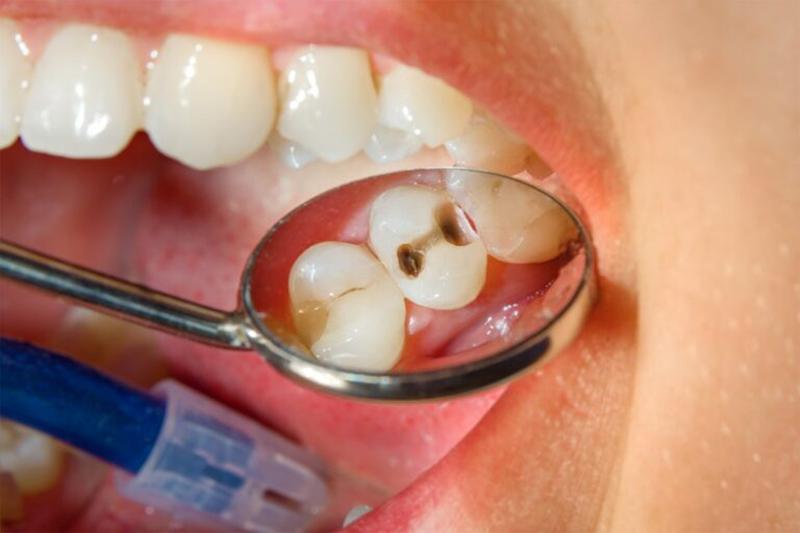Cavities in children
Cavities, also known as dental caries, are a common problem in children. They occur when bacteria in the mouth produce acid that erodes the surface of the teeth, causing holes or pits to form. Children are particularly susceptible to cavities for several reasons, including:
- Poor oral hygiene: Children who don’t brush and floss regularly are more likely to develop cavities.
- High sugar intake: Consuming sugary foods and drinks increases the amount of bacteria in the mouth and raises the risk of cavities.
- Limited exposure to fluoride: Fluoride is a mineral that helps strengthen tooth enamel, making it more resistant to decay. Children who don’t have access to fluoride in their water or toothpaste are more likely to develop cavities.
- Undiagnosed dental problems: Children with undiagnosed dental problems, such as a cleft palate or misaligned teeth, are more susceptible to cavities.
To prevent cavities in children, it’s important to establish good oral hygiene habits, limit their sugar intake, and ensure they have access to fluoride. Regular dental check-ups and cleanings can also help prevent and detect cavities early on. If a child does get a cavity, it can be treated with a filling, which involves removing the decayed portion of the tooth and filling the hole with a material, such as amalgam or composite resin.
- How to prevent cavities in children?
Preventing cavities in children is an important part of maintaining their oral health. Here are some steps you can take to help prevent cavities in children:
- Promote good oral hygiene: Encourage your child to brush their teeth twice a day with a fluoride toothpaste and floss daily. Teach them the importance of proper brushing and flossing techniques and help them establish a routine.
- Limit sugary foods and drinks: Reduce your child’s consumption of sugary foods, such as candy and soda, and encourage them to drink water instead. If your child does have sugary foods, encourage them to brush their teeth or chew sugar-free gum afterward to help remove the sugar from their mouth.
- Provide fluoride: Make sure your child has access to fluoride, either through their drinking water or toothpaste. If necessary, your dentist may recommend fluoride supplements or topical fluoride treatments.
- Encourage healthy habits: Teach your child to eat a healthy diet that’s rich in calcium and other minerals that are important for oral health. Encourage them to get enough sleep and exercise, as these habits can also promote good oral health.
- Regular dental check-ups: Take your child to the dentist regularly for check-ups and cleanings. This will allow your dentist to monitor their oral health and detect any problems early on.
By following these steps, you can help prevent cavities and maintain your child’s oral health. It’s never too early to start promoting good oral hygiene habits in children, and taking these steps now can help protect their teeth for a lifetime.
- How are dental cavities in children treated?
The treatment for dental cavities in children depends on the severity of the decay. The most common treatments include:
- Fillings: If a cavity is caught in its early stages, a dentist may be able to treat it with a filling. Fillings involve removing the decayed portion of the tooth and filling the hole with a material, such as amalgam or composite resin.
- Crowns: If a cavity is more advanced and has damaged a large portion of the tooth, a dentist may recommend a crown. A crown is a cap that fits over the entire visible portion of the tooth and protects it from further decay.
- Root canal: In some cases, a cavity can reach the innermost layer of the tooth, known as the pulp. When this happens, a dentist may recommend a root canal, which involves removing the infected or damaged pulp and filling the inside of the tooth with a material to prevent further infection.
- Extractions: If a cavity is too advanced to be treated with a filling or crown, a dentist may need to extract the tooth. Extractions are typically a last resort, as they can cause changes in the bite and the alignment of other teeth.
It’s important to treat cavities as soon as they’re detected, as they can progress quickly and cause more extensive and costly damage. If your child has a cavity, be sure to follow your dentist’s instructions for treatment and follow-up care, and encourage your child to maintain good oral hygiene habits to prevent future cavities.
- How are milk teeth cavities treated?
Treatment for cavities in baby teeth (also known as milk teeth or primary teeth) is similar to the treatment for cavities in permanent teeth, but there are some differences to consider. Here are the most common treatments for milk teeth cavities:
- Fillings: If a cavity is small, a dentist may be able to treat it with a filling. Fillings involve removing the decayed portion of the tooth and filling the hole with a material, such as amalgam or composite resin.
- Crowns: If a cavity is more advanced and has damaged a large portion of the tooth, a dentist may recommend a crown. Crowns are typically made of stainless steel or a tooth-colored material, and they fit over the entire visible portion of the tooth, protecting it from further decay.
- Pulpotomy: If a cavity has reached the innermost layer of the tooth (the pulp), a dentist may recommend a pulpotomy. This procedure involves removing the infected or damaged portion of the pulp and placing a medication on the remaining healthy pulp to help it heal.
- Extractions: In some cases, a cavity may be too advanced to be treated, and a dentist may need to extract the affected tooth. While this is not ideal, it’s important to extract a decayed tooth to prevent the spread of infection and preserve the health of the surrounding teeth and gums.
It’s important to note that even though baby teeth are eventually replaced by permanent teeth, it’s still important to treat cavities in baby teeth promptly and properly. Untreated cavities in baby teeth can cause pain and lead to more serious dental problems, such as infections, which can affect the development of permanent teeth.













